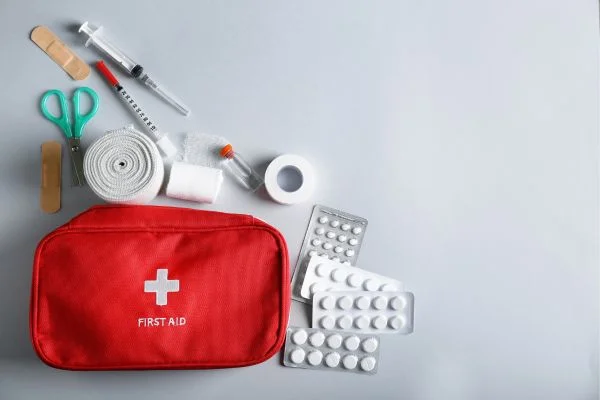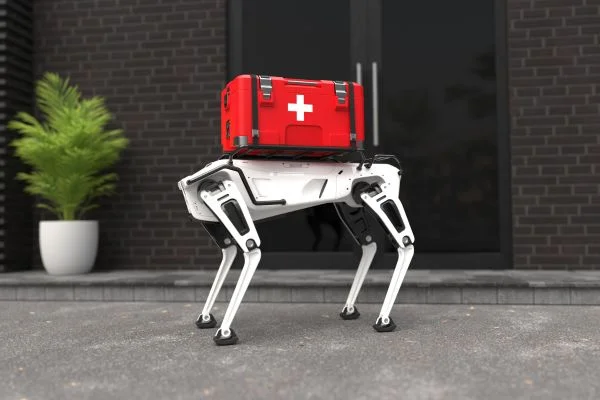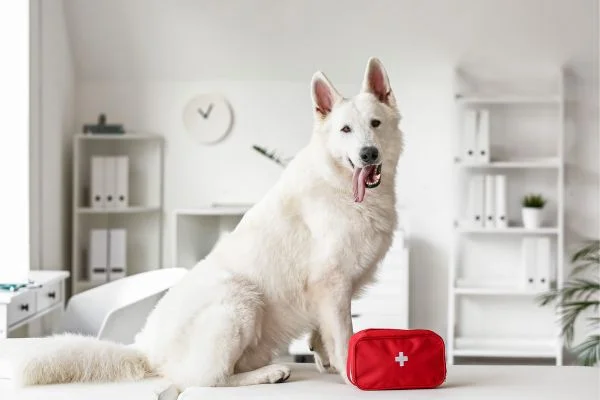Dogs are some of the most loving and loyal creatures on Earth, but they can also be very clumsy. Unfortunately, an accident can happen anytime, even when you’re not home. So what to put in a dog first aid kit?
Dog emergency kits can help you handle minor injuries like cuts or scrapes quickly and efficiently so that you don’t have to worry about your pup suffering needlessly while you’re away. Here’s everything we recommend including in a doggy first aid kit:
What To Put In a Dog First Aid Kit- All Essentials
The following items should also be included in a comprehensive first aid kit for dogs:

Gauze and Bandage Material
When your dog gets a cut or scrape, you should place a bandage over the wound to stop bleeding and keep it clean. You can use gauze to clean and cover wounds, but don’t forget those open cuts! If you have space in your first aid kit, include some extra gauze pads as well – they can help clean up the blood that gets onto furniture or clothing (or even carpeting).
If your dog has an open wound with exposed flesh, such as an abrasion or laceration still bleeding, make sure to cover it with something non-sticky, like Telfa pads, so it doesn’t stick together while healing.
Cotton Swabs
Cotton swabs are handy for cleaning wounds and applying medication and ointment to the ears and nose. In addition, the thin end of a cotton swab can be used to clean out any debris that might be stuck in your dog’s ear canal. If you’re worried about what could be lurking in there, take it to your vet.
If your dog has an eye injury or conjunctivitis (pink eye), a cotton swab helps remove discharge from the eyes before applying antibiotic ointment or drops. Now you know what to put in a dog first aid kit while traveling.
Hydrogen Peroxide
Hydrogen peroxide is the go-to for cleaning wounds and is an essential part of any first aid kit. It can also be used to clean debris from the wound, which is excellent if you don’t have access to a sterile saline solution.
However, hydrogen peroxide shouldn’t be used on open wounds because it will sting and burn the tissue. Hydrogen peroxide also can cause irritation to dogs with dark-colored fur (such as black or Dalmatian), so only use this product in light-colored furred dogs or ask your vet before using it on any animal!
Planning a camping trip with your canine companion? Check out our comprehensive camping with a dog checklist for a successful and enjoyable outdoor adventure. Click Here!
Peroxide-Free Cleaner
You can also make your cleaning solution. Mix one part vinegar with two parts water and spray it on the stain. This will remove any blood and other organic matter, which will help prevent bacteria from growing in the fabric or carpet.
If you’re using hydrogen peroxide, bleach, or vinegar to clean a dog first aid kit spill, rinse off thoroughly after spraying or wiping out the area. If you’re using an antibacterial cleanser designed for dogs, follow all instructions on the package before returning your pup inside his crate again.
Antibiotic Ointment
The antibiotic ointment helps prevent infections in minor cuts and scrapes, hot spots (infected hairless areas on the skin), and wounds. It can also help treat eye and ear infections.
The most important thing to remember when using antibiotic ointment is to apply it to your dog’s wound as soon as possible after you notice your dog has been injured.
Adhesive Tape and Scissors
You can use adhesive tape to secure gauze and bandages in place by applying them to the body. When it comes to cutting adhesive tape, bandages, or any material that you might need for first aid, scissors are essential.
Disposable Gloves
You and your dog will both be protected from potential contamination by wearing disposable gloves while walking. As a result, they are extremely important when it comes to dealing with wounds, administering medications, or performing any type of first aid.
Tweezers and Tick Remover
When you clean your dog’s skin, tweezers can be useful for removing splinters, debris, or small foreign objects. To remove ticks safely without leaving their mouthparts behind, which can cause infection, it is necessary to use a tick remover.
Ready to explore the great outdoors with your pup? Discover how to go camping with a dog and make unforgettable memories together. Click Here!
Instant Cold Pack
When injuries, strains, or sprains result in swelling or pain, an instant cold pack can provide immediate relief. Taking it can help reduce inflammation and discomfort in the body.
Rectal Thermometer
If you wish to keep an eye on your dog’s temperature, it is important to use a rectal thermometer. Temperatures that suddenly rise or decrease could indicate fever or an infection, while those that suddenly drop could indicate hypothermia or a cold.
Styptic Powder or Gel
When a minor nail injury results in bleeding due to styptic powder or gel, this can be very useful. In addition to promoting blood clotting, it helps to stop bleeding by preventing blood loss.
Muzzle and Leash
In an emergency, even some of the gentlest dogs can react aggressively or fearfully due to the pain they are suffering. An effective way to prevent accidental bites is to use a muzzle. During treatment, you may need to restrain your dog with the help of a leash.
Eye Wash
If your dog’s eyes are irritated or filled with debris, use an eye wash or a saline solution to flush the debris out of their eyes. You need to keep their eyes clean and free from potential hazards so that they can see clearly.
Curious about leaving your dog in a tent while camping? Explore our guide on ensuring your furry friend’s comfort and safety when camping. Click Here!

Oral Syringe or Turkey Baster
The use of an oral syringe or turkey baster can be used to administer liquids to your dog, such as water or medicine, especially if the dog is unable to drink or swallow normally due to a medical condition.
Antihistamines
If you are experiencing allergic reactions or bug bites, you might be able to benefit from using antihistamines. Consult your veterinarian before taking anything. You need to make sure that you know what dosage you should give your dog according to its breed and size.
Emergency Contact Information
It is important to keep a list of important telephone numbers with you at all times, including the number of your regular veterinarian, an emergency veterinary clinic, and the number for animal poison control in case of an accidental poisoning.
Medication and Medical Records
You should also include any medications that your dog may require and a copy of his or her medical record if your dog has specific medical conditions that may require treatment by another veterinarian in case of an emergency.
Emergency Food and Water
It is important to pack a small amount of your dog’s regular food and bottled water with you if you will need to sustain them in case of unexpected circumstances or while waiting for veterinary care.
Blanket or Towel
Using a blanket or towel can provide warmth and comfort for your dog and serve as an improvised stretcher in the event that your dog needs to be moved without further causing further damage to their body.
Pet First Aid Booklet
In case you are faced with an unfamiliar situation, having a dog first aid booklet on hand can give you step-by-step instructions on what to do in case you are unsure of what to do.
You should know basic pet first aid and CPR techniques if you have a first aid kit. You should also ask your vet for advice about your dog’s health. Now you know what to put in a dog first aid kit while camping.
Conclusion
Hopefully, this post has made you aware of the importance of having a dog first aid kit and what should go into it. As a responsible dog owner, it’s your job to ensure your pets are safe and healthy. Ensure they have all the necessary vaccines so they don’t get sick or injured. We hope now you know what to put in a dog first aid kit. Enjoy Reading:)!



